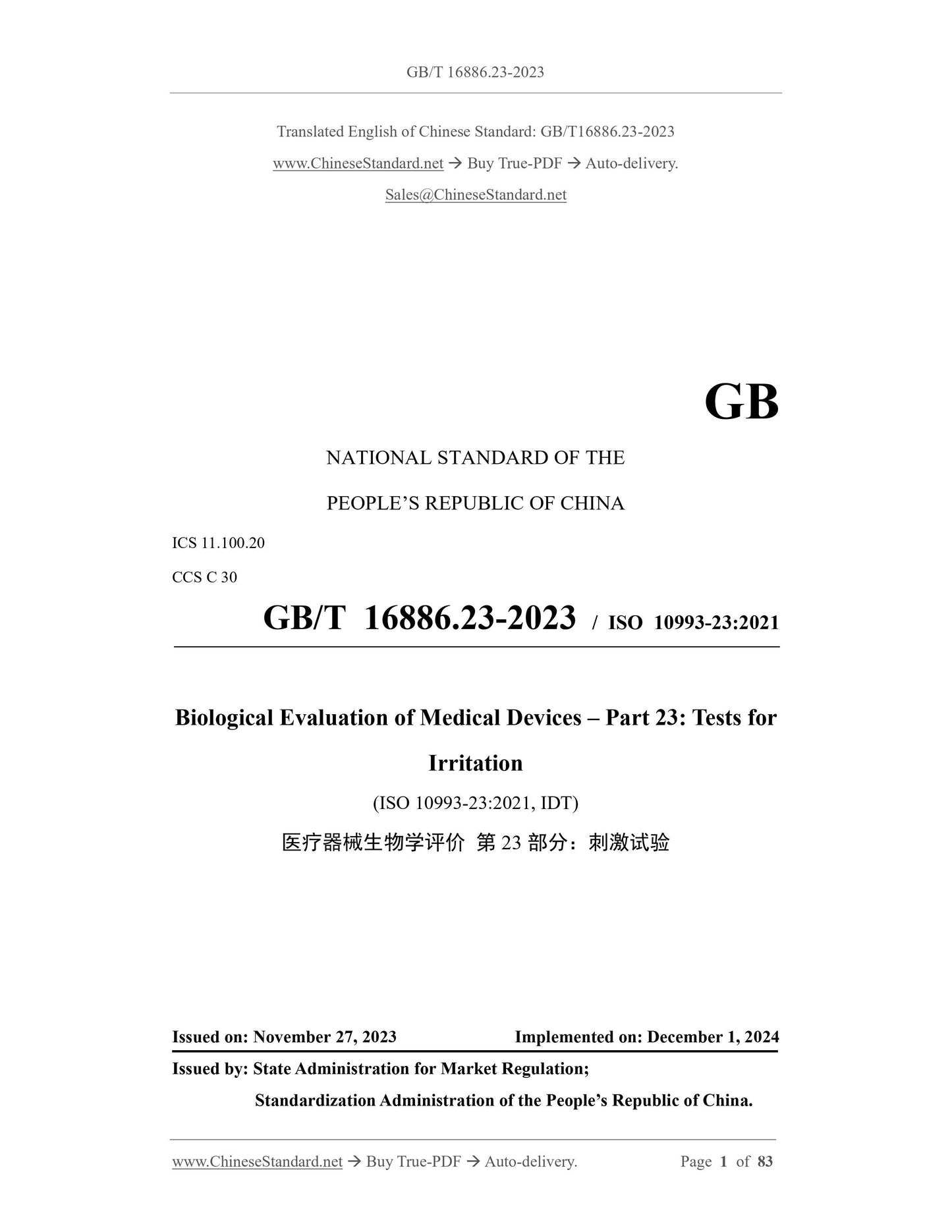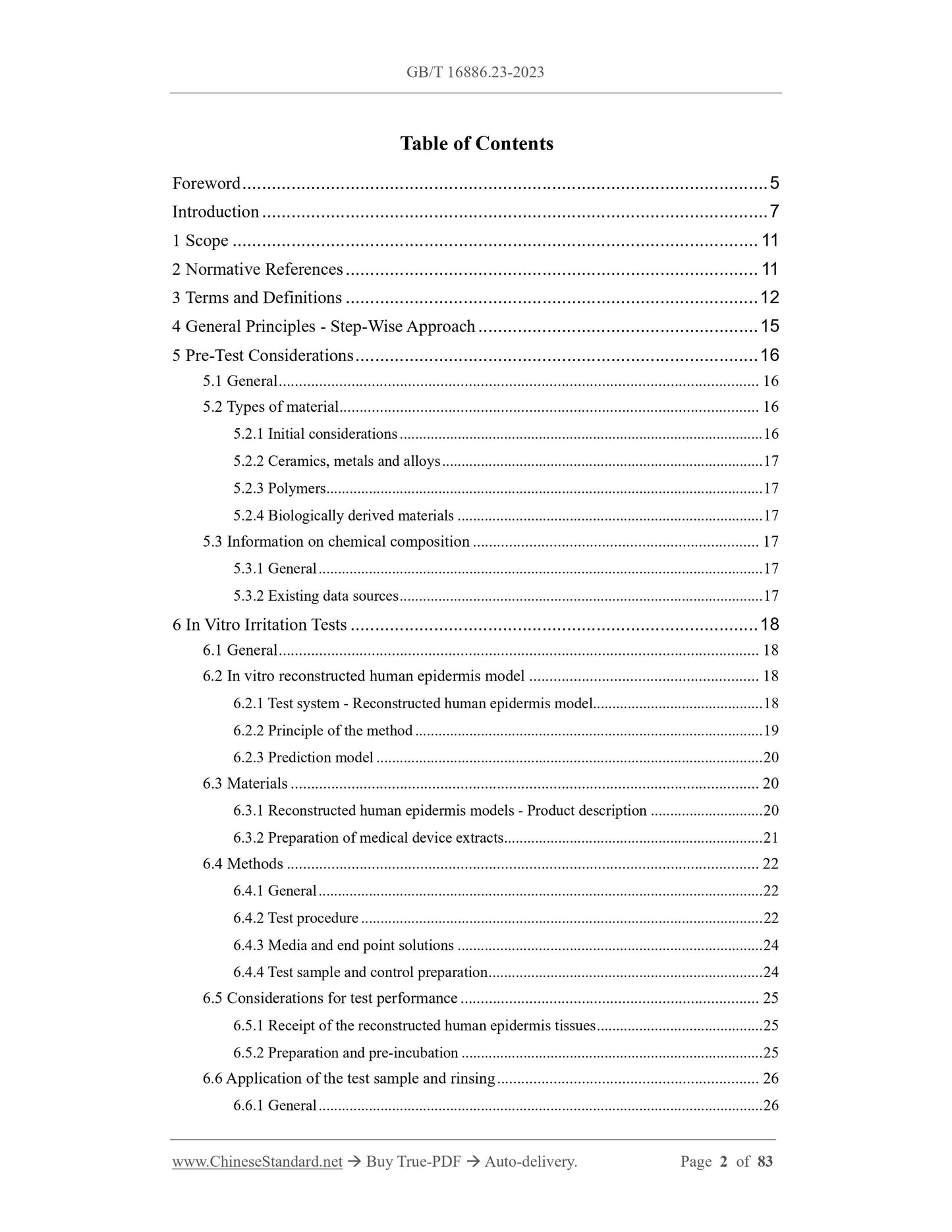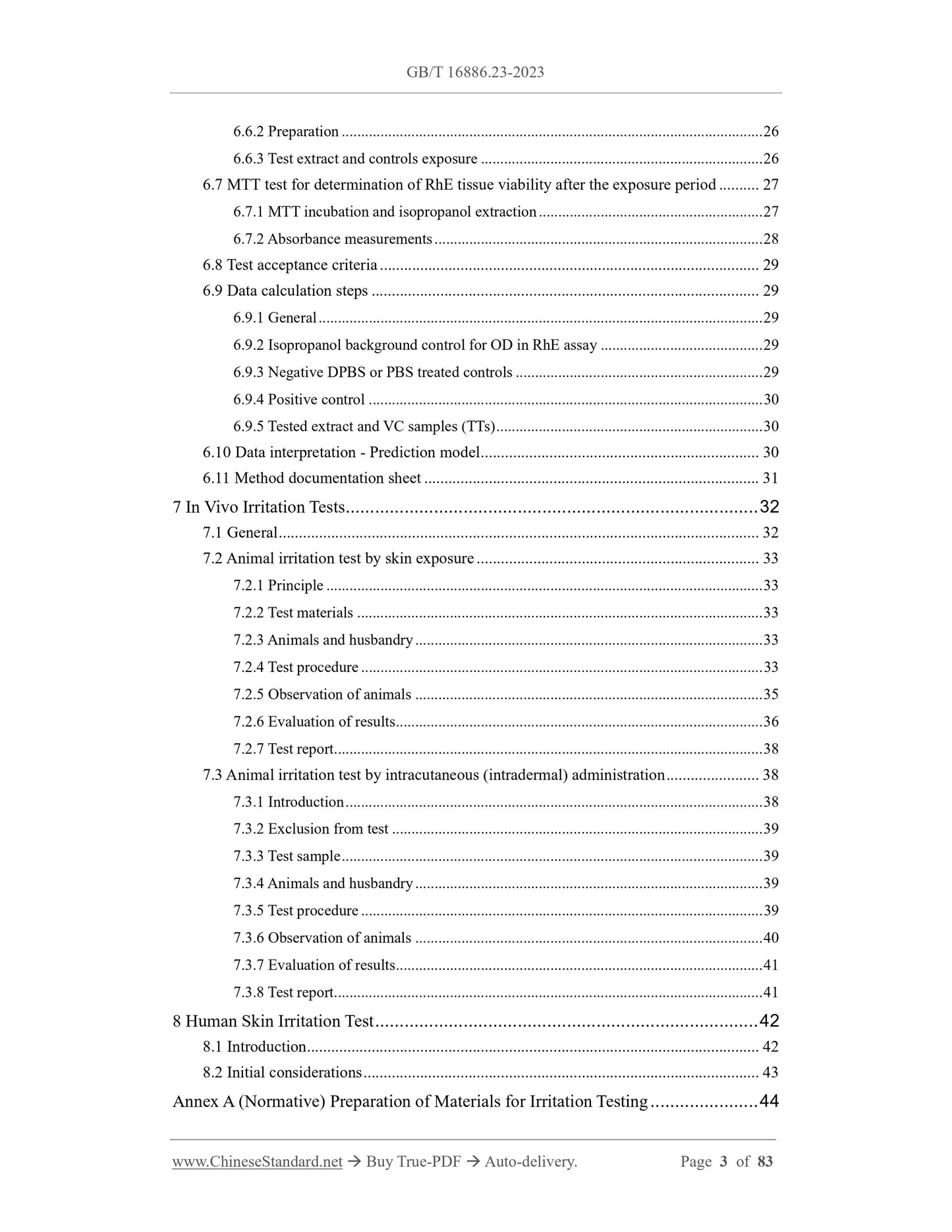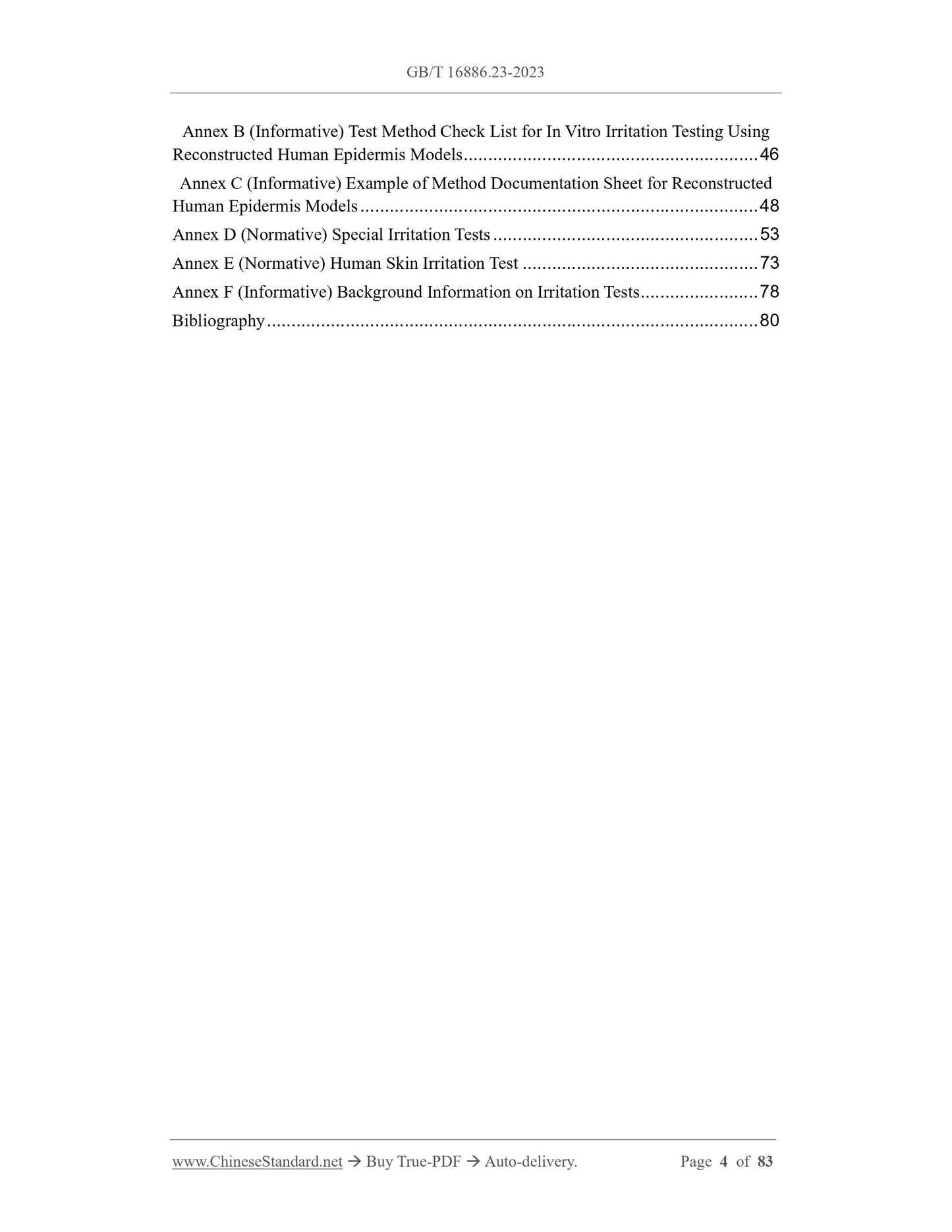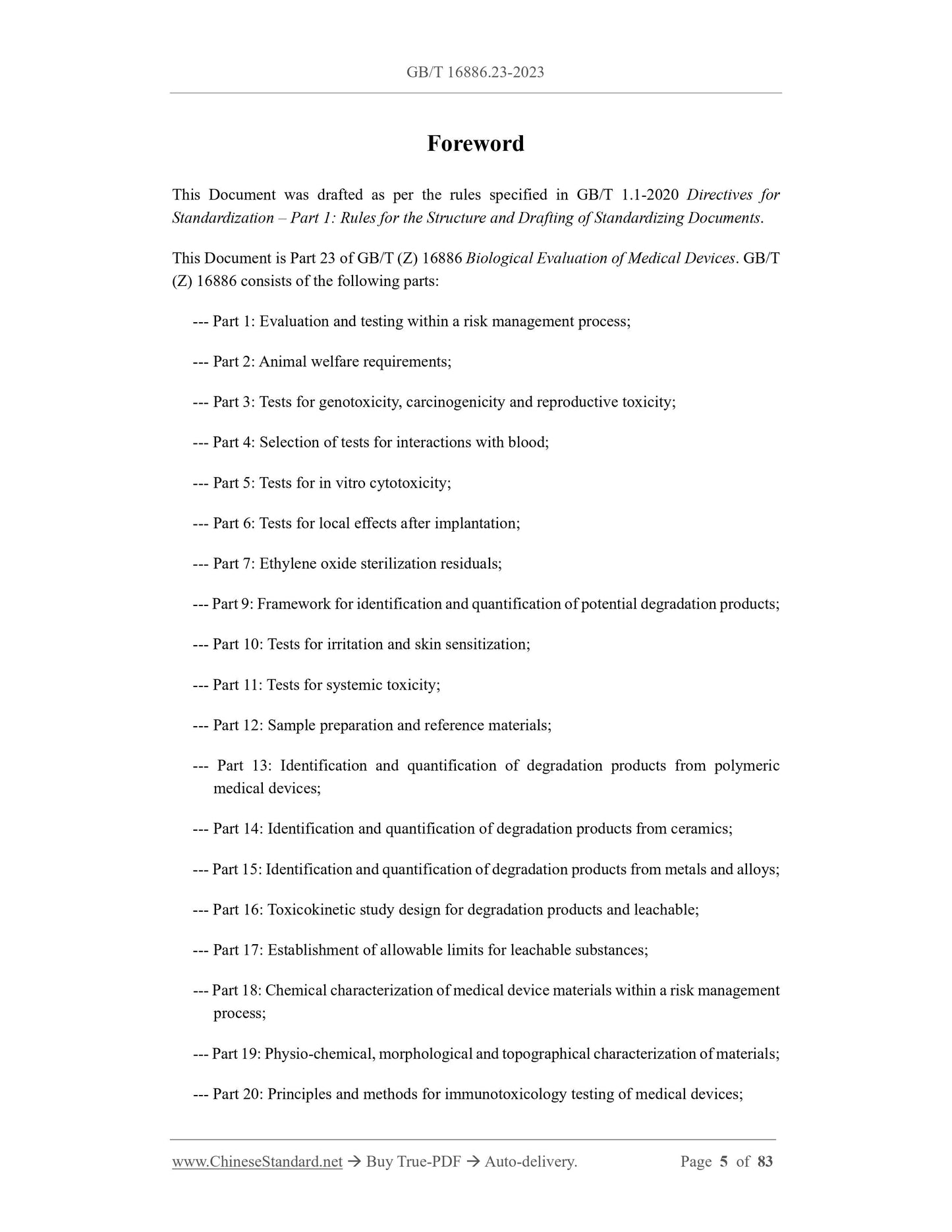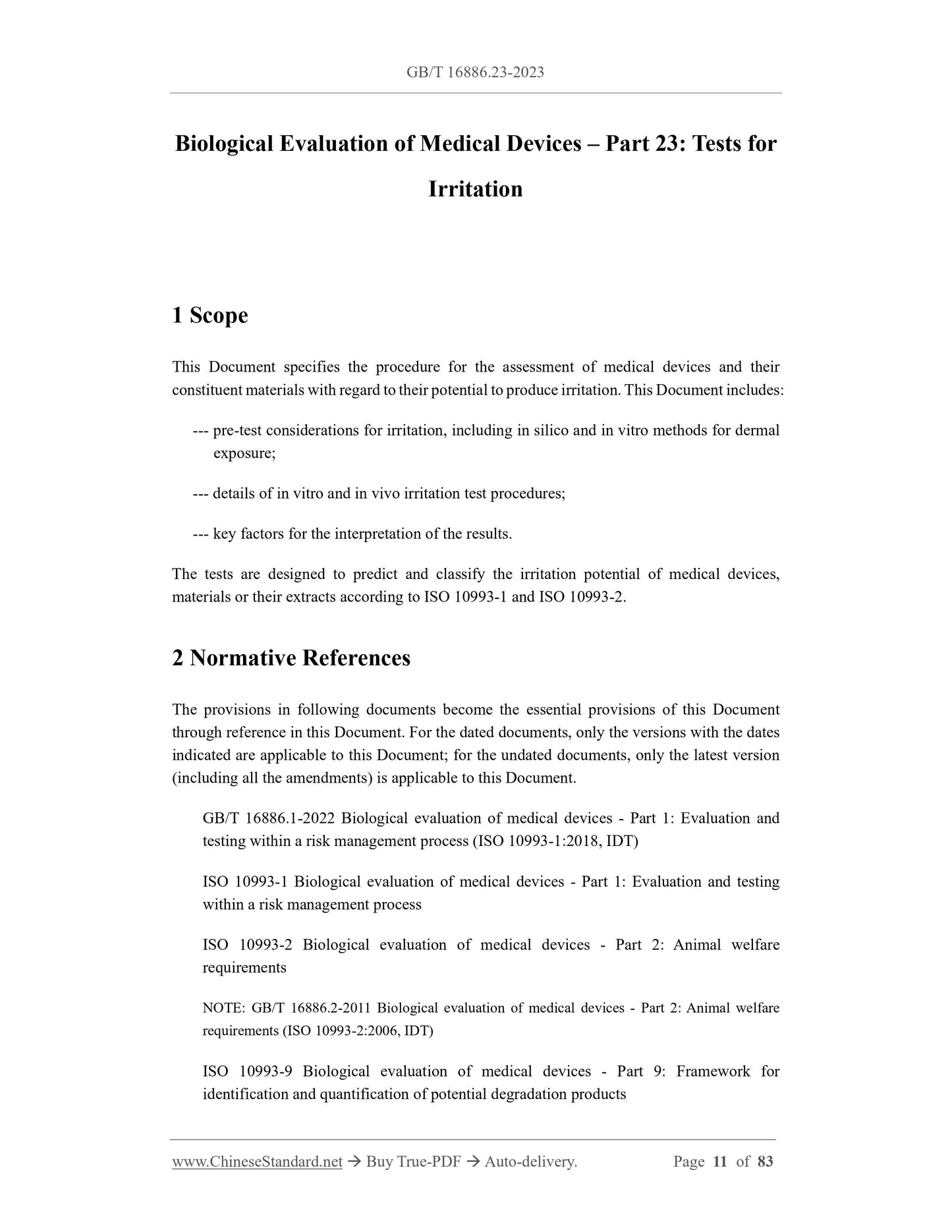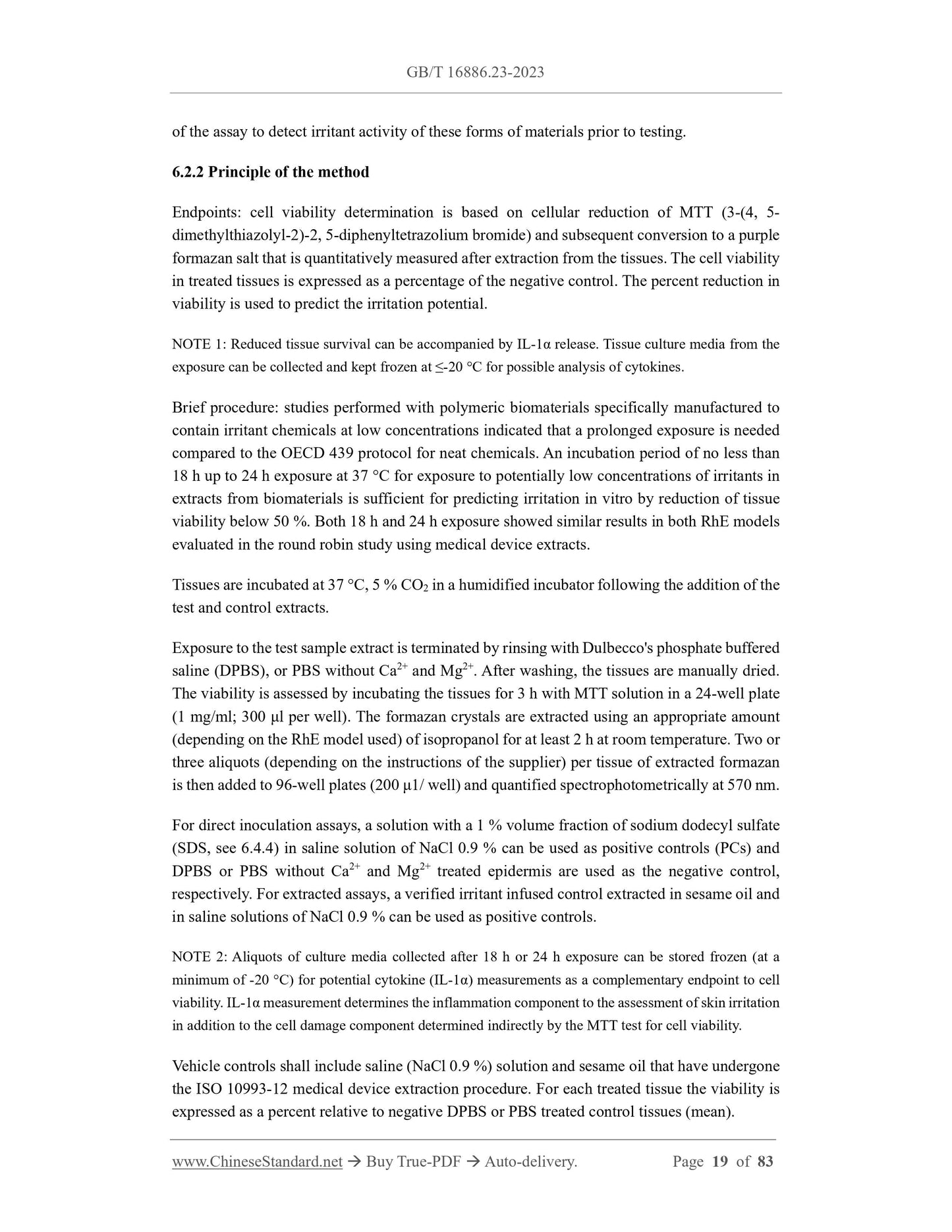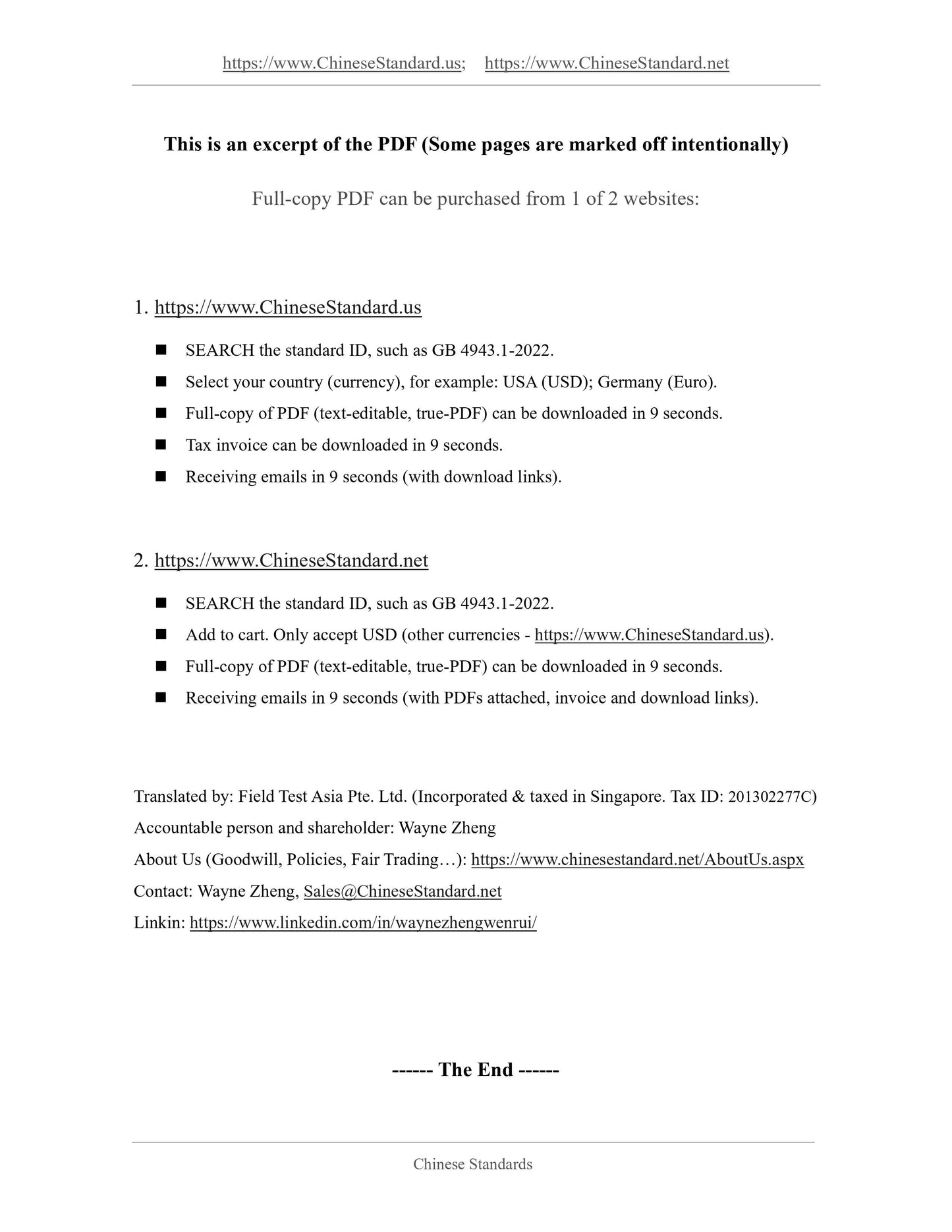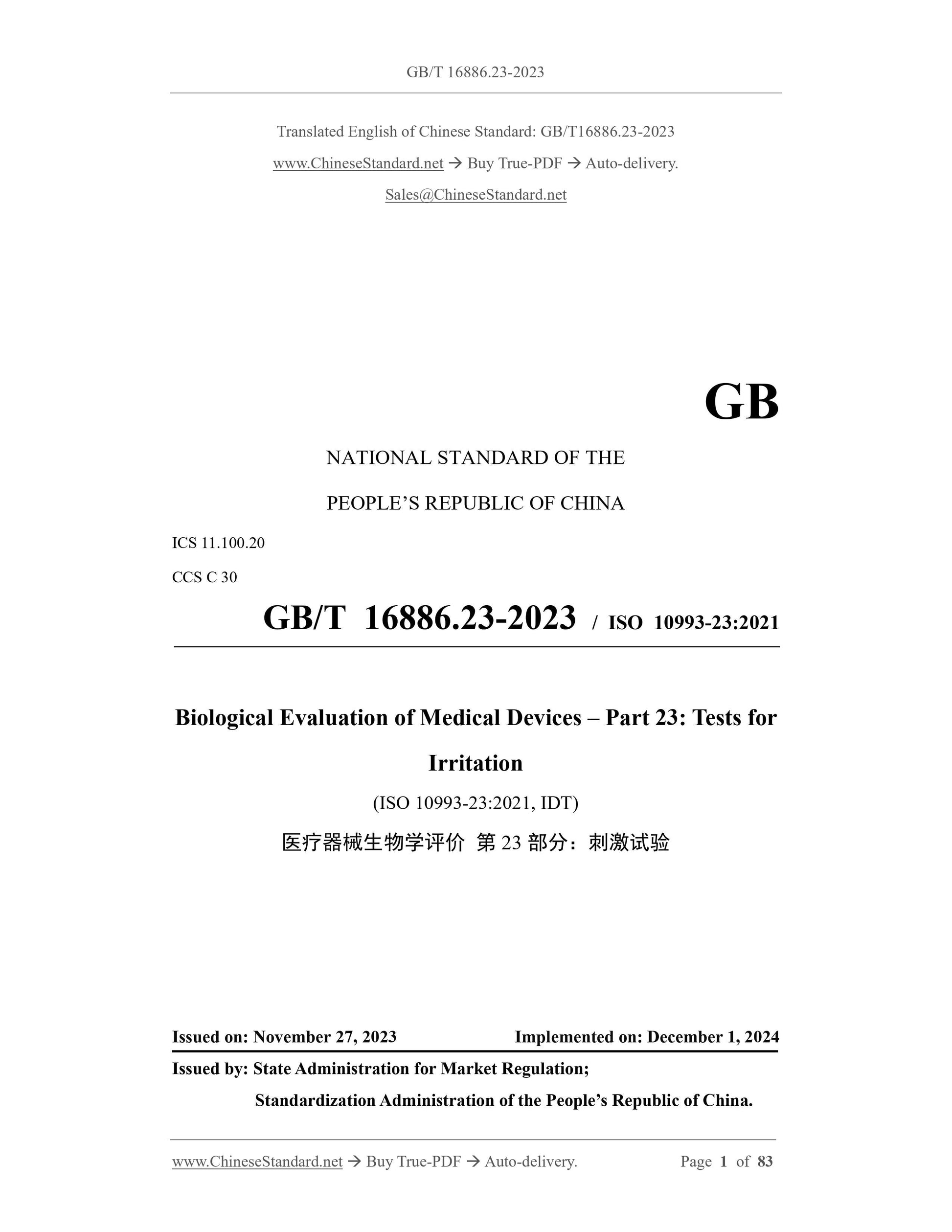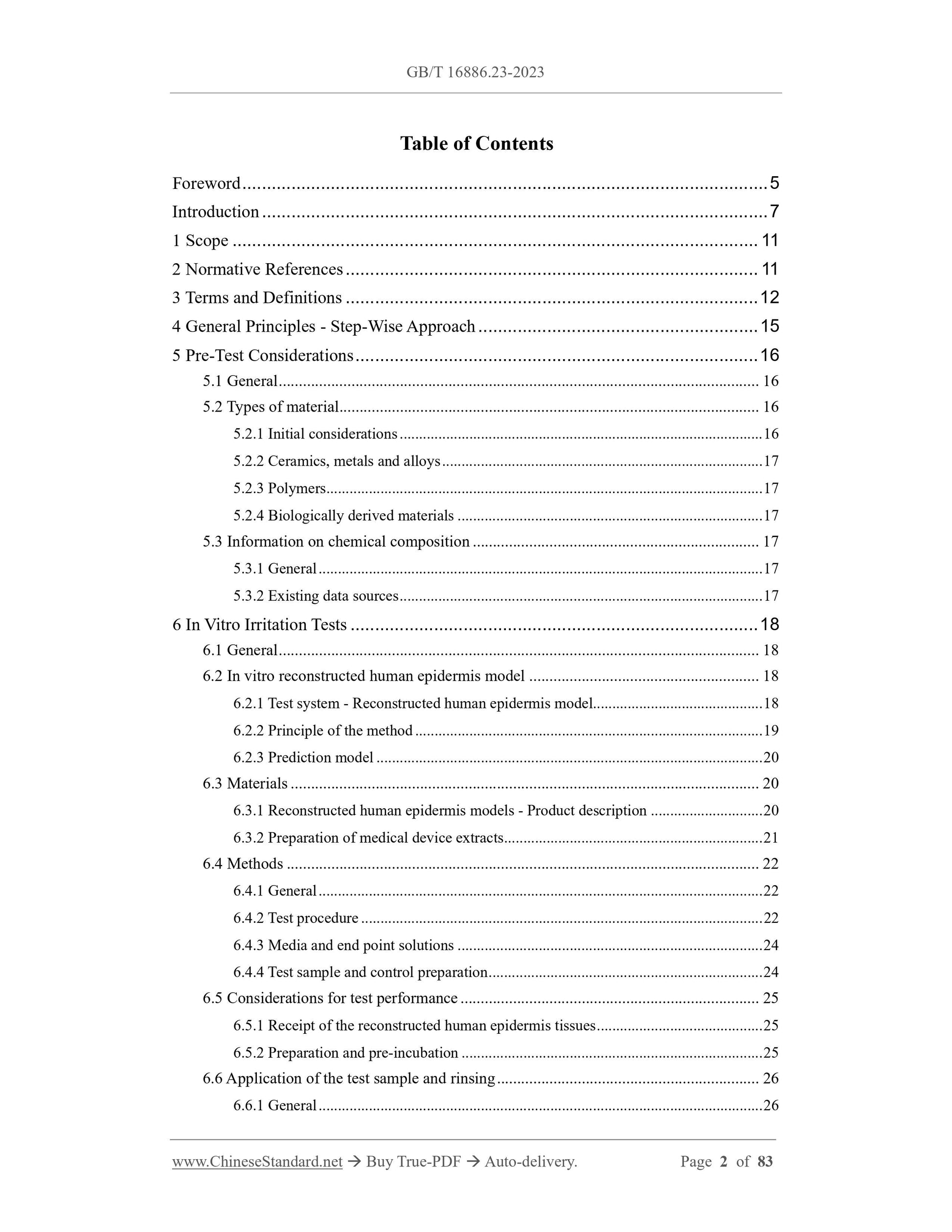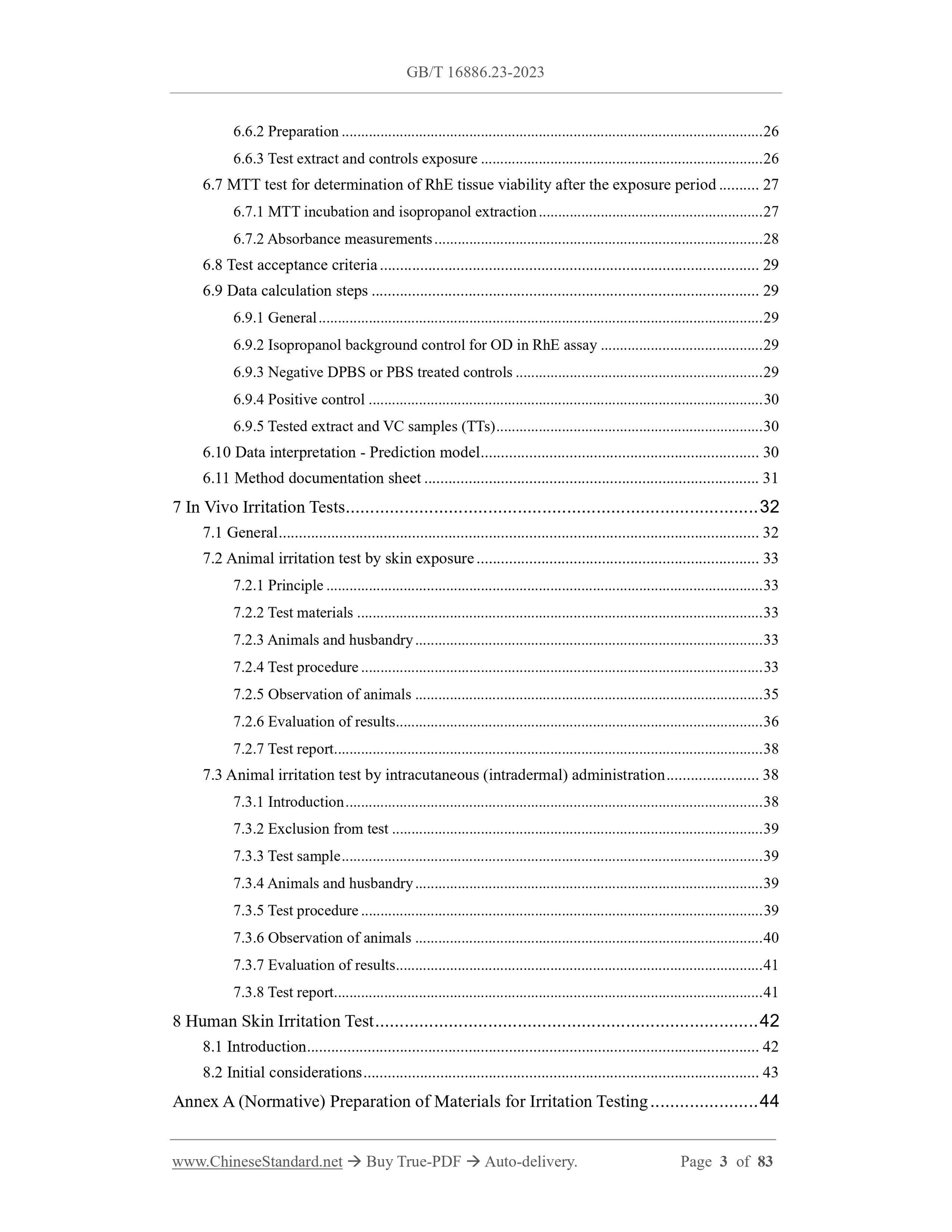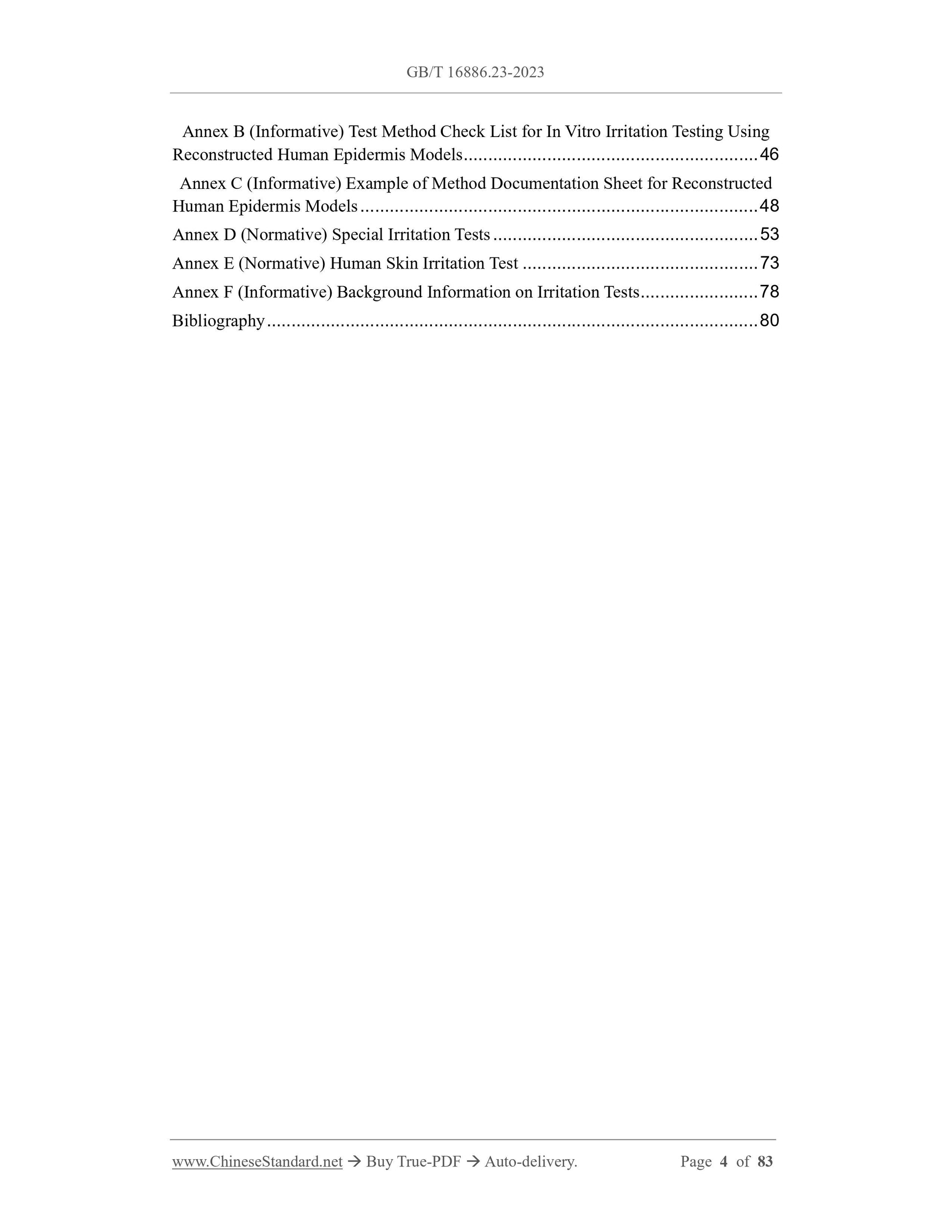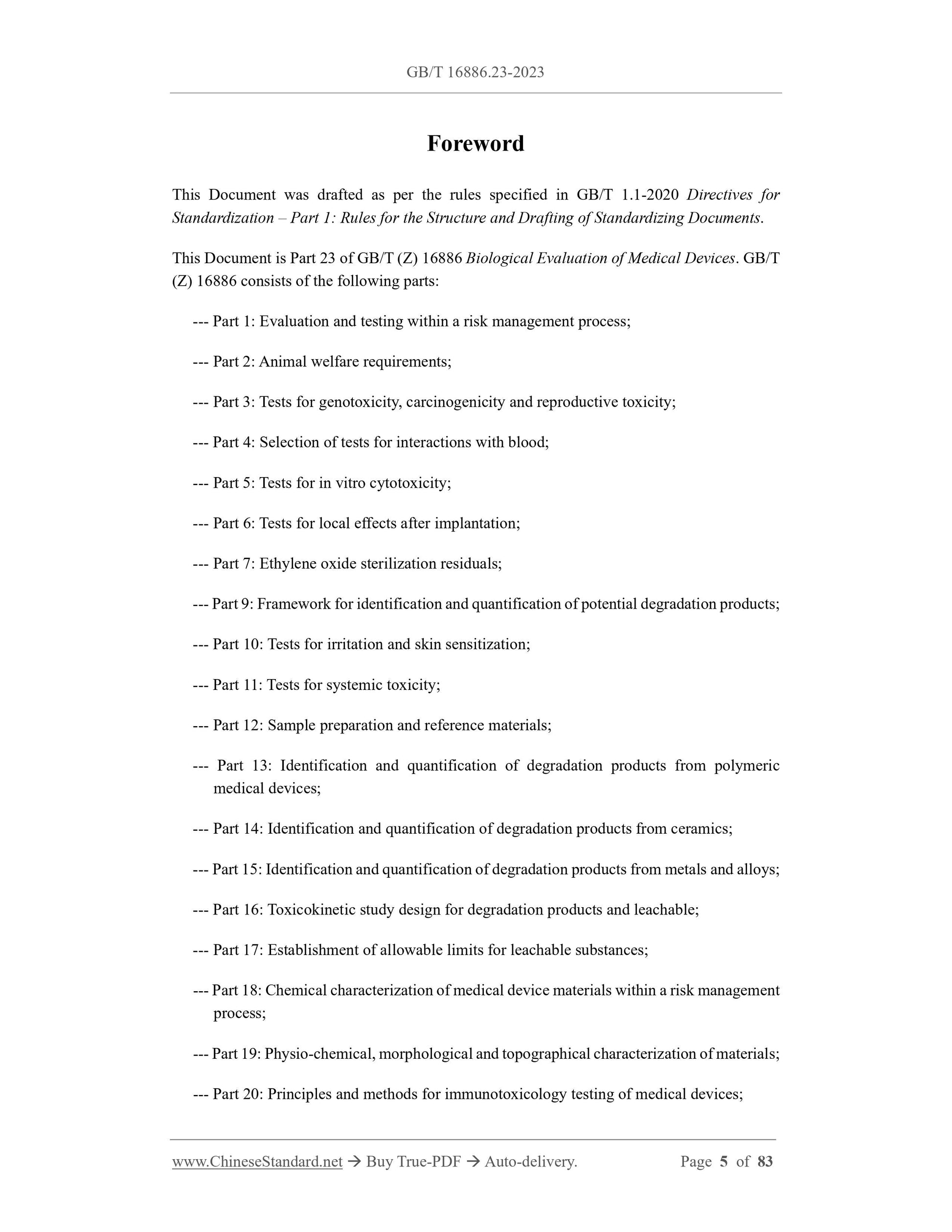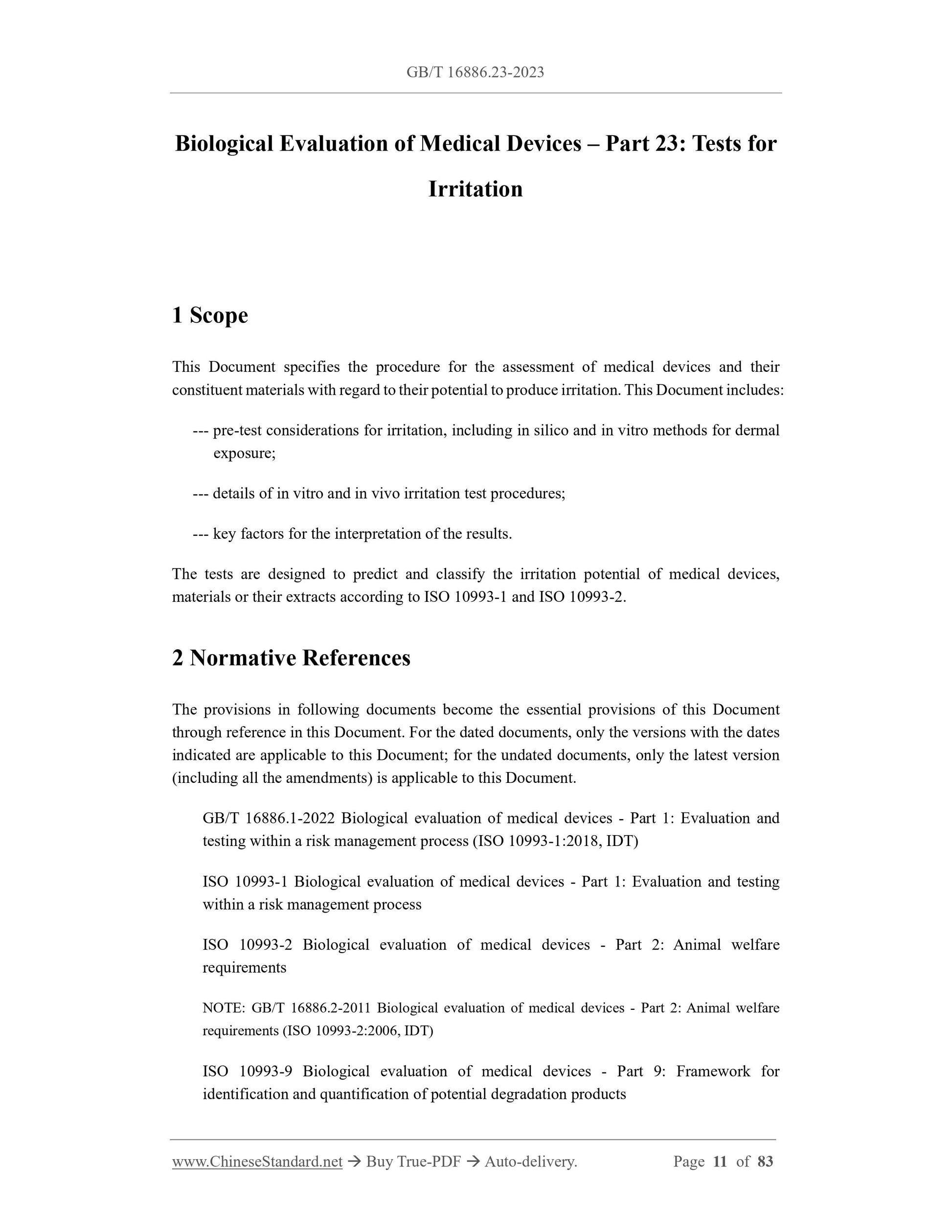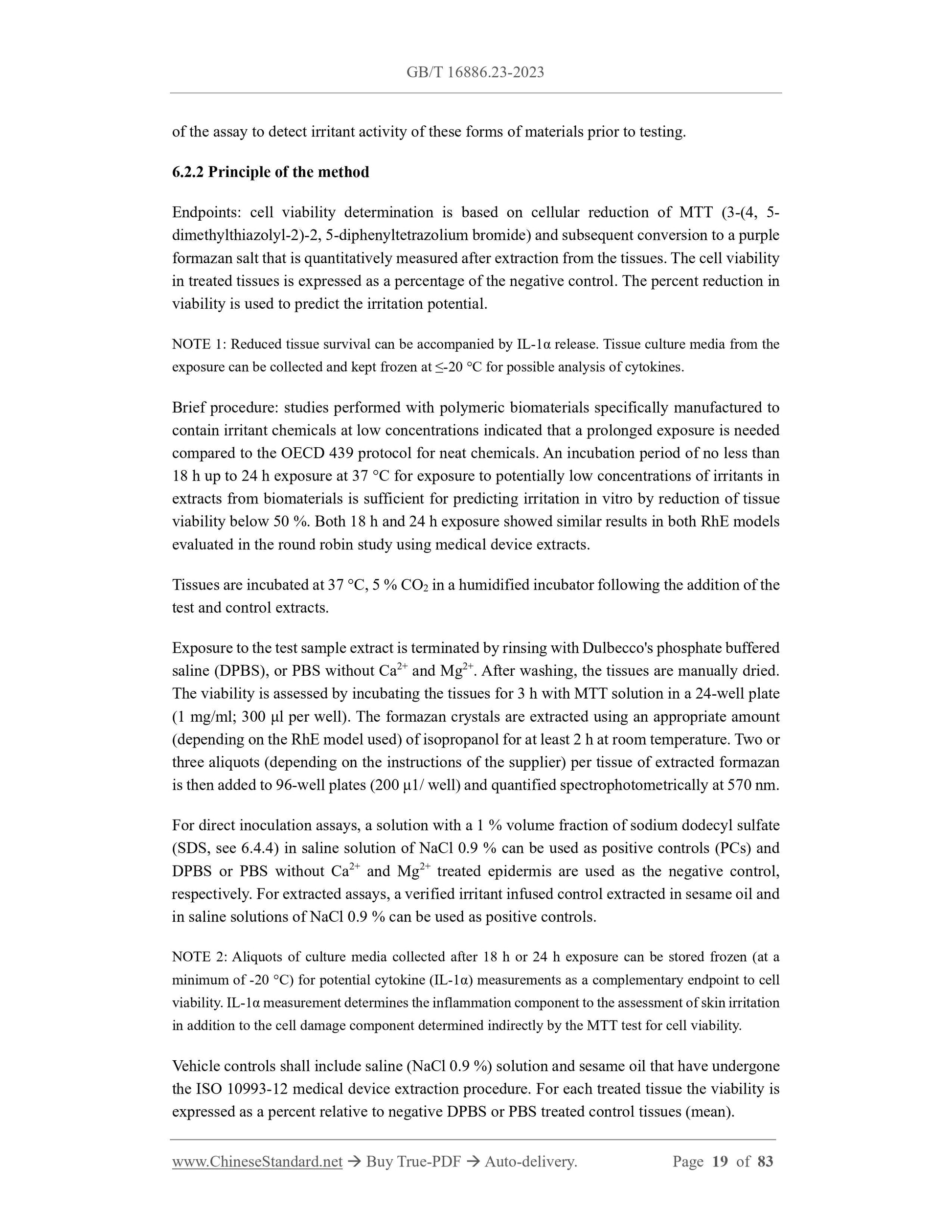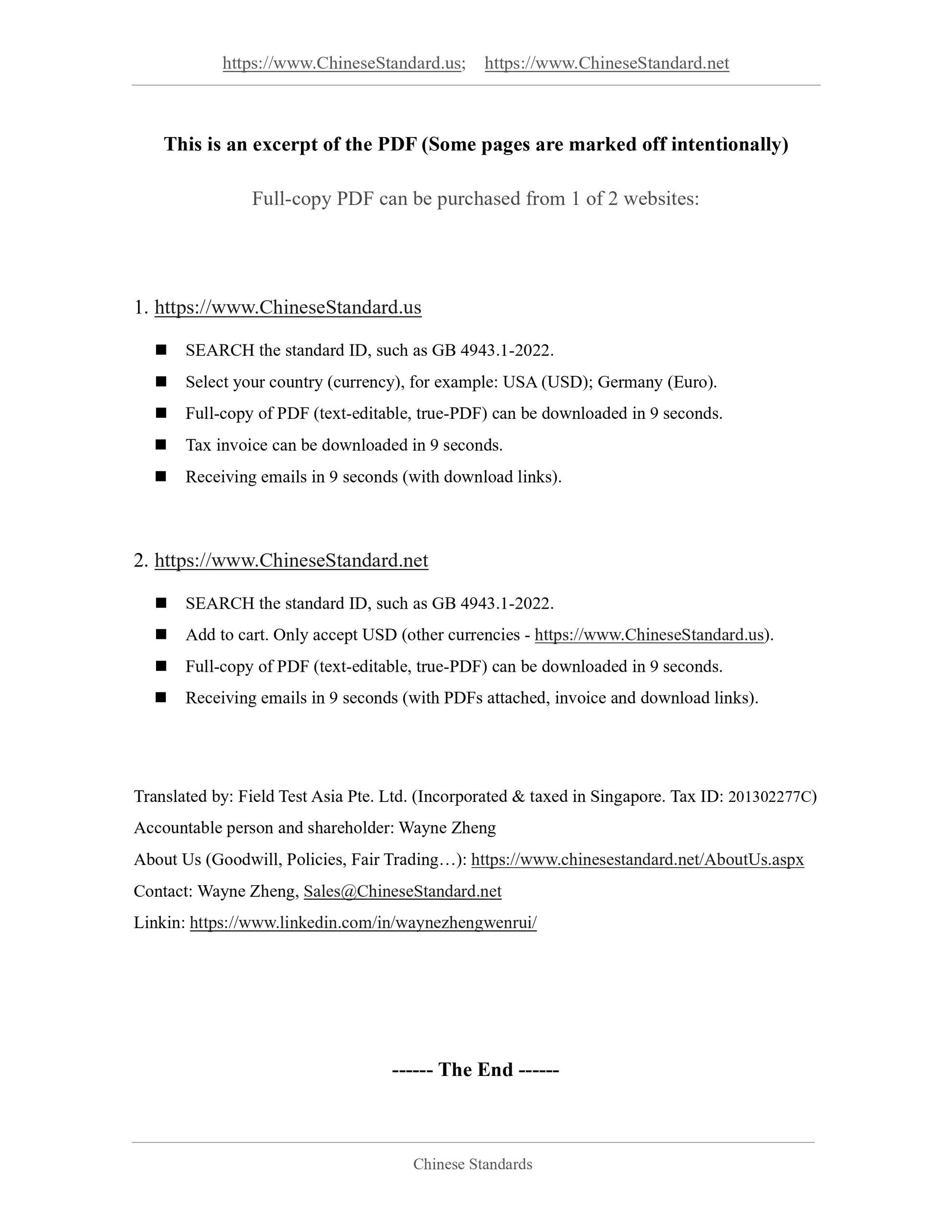1
/
of
8
PayPal, credit cards. Download editable-PDF and invoice in 1 second!
GB/T 16886.23-2023 English PDF (GBT16886.23-2023)
GB/T 16886.23-2023 English PDF (GBT16886.23-2023)
Regular price
$995.00 USD
Regular price
Sale price
$995.00 USD
Unit price
/
per
Shipping calculated at checkout.
Couldn't load pickup availability
Delivery: 3 seconds. Download true-PDF + Invoice.
Get QUOTATION in 1-minute: Click GB/T 16886.23-2023
Historical versions: GB/T 16886.23-2023
Preview True-PDF (Reload/Scroll if blank)
GB/T 16886.23-2023: Biological evaluation of medical devices -- Part 23: Tests for irritation
GB/T 16886.23-2023
GB
NATIONAL STANDARD OF THE
PEOPLE’S REPUBLIC OF CHINA
ICS 11.100.20
CCS C 30
GB/T 16886.23-2023 / ISO 10993-23:2021
Biological Evaluation of Medical Devices – Part 23: Tests for
Irritation
(ISO 10993-23:2021, IDT)
ISSUED ON: NOVEMBER 27, 2023
IMPLEMENTED ON: DECEMBER 1, 2024
Issued by: State Administration for Market Regulation;
Standardization Administration of the People’s Republic of China.
Table of Contents
Foreword ... 5
Introduction ... 7
1 Scope ... 11
2 Normative References ... 11
3 Terms and Definitions ... 12
4 General Principles - Step-Wise Approach ... 15
5 Pre-Test Considerations ... 16
5.1 General ... 16
5.2 Types of material ... 16
5.2.1 Initial considerations ... 16
5.2.2 Ceramics, metals and alloys ... 17
5.2.3 Polymers ... 17
5.2.4 Biologically derived materials ... 17
5.3 Information on chemical composition ... 17
5.3.1 General ... 17
5.3.2 Existing data sources ... 17
6 In Vitro Irritation Tests ... 18
6.1 General ... 18
6.2 In vitro reconstructed human epidermis model ... 18
6.2.1 Test system - Reconstructed human epidermis model ... 18
6.2.2 Principle of the method ... 19
6.2.3 Prediction model ... 20
6.3 Materials ... 20
6.3.1 Reconstructed human epidermis models - Product description ... 20
6.3.2 Preparation of medical device extracts ... 21
6.4 Methods ... 22
6.4.1 General ... 22
6.4.2 Test procedure ... 22
6.4.3 Media and end point solutions ... 24
6.4.4 Test sample and control preparation ... 24
6.5 Considerations for test performance ... 25
6.5.1 Receipt of the reconstructed human epidermis tissues ... 25
6.5.2 Preparation and pre-incubation ... 25
6.6 Application of the test sample and rinsing ... 26
6.6.1 General ... 26
6.6.2 Preparation ... 26
6.6.3 Test extract and controls exposure ... 26
6.7 MTT test for determination of RhE tissue viability after the exposure period ... 27
6.7.1 MTT incubation and isopropanol extraction ... 27
6.7.2 Absorbance measurements ... 28
6.8 Test acceptance criteria ... 29
6.9 Data calculation steps ... 29
6.9.1 General ... 29
6.9.2 Isopropanol background control for OD in RhE assay ... 29
6.9.3 Negative DPBS or PBS treated controls ... 29
6.9.4 Positive control ... 30
6.9.5 Tested extract and VC samples (TTs) ... 30
6.10 Data interpretation - Prediction model ... 30
6.11 Method documentation sheet ... 31
7 In Vivo Irritation Tests ... 32
7.1 General ... 32
7.2 Animal irritation test by skin exposure ... 33
7.2.1 Principle ... 33
7.2.2 Test materials ... 33
7.2.3 Animals and husbandry ... 33
7.2.4 Test procedure ... 33
7.2.5 Observation of animals ... 35
7.2.6 Evaluation of results ... 36
7.2.7 Test report ... 38
7.3 Animal irritation test by intracutaneous (intradermal) administration ... 38
7.3.1 Introduction ... 38
7.3.2 Exclusion from test ... 39
7.3.3 Test sample ... 39
7.3.4 Animals and husbandry ... 39
7.3.5 Test procedure ... 39
7.3.6 Observation of animals ... 40
7.3.7 Evaluation of results ... 41
7.3.8 Test report ... 41
8 Human Skin Irritation Test ... 42
8.1 Introduction ... 42
8.2 Initial considerations ... 43
Annex A (Normative) Preparation of Materials for Irritation Testing ... 44
Annex B (Informative) Test Method Check List for In Vitro Irritation Testing Using
Reconstructed Human Epidermis Models ... 46
Annex C (Informative) Example of Method Documentation Sheet for Reconstructed
Human Epidermis Models ... 48
Annex D (Normative) Special Irritation Tests ... 53
Annex E (Normative) Human Skin Irritation Test ... 73
Annex F (Informative) Background Information on Irritation Tests ... 78
Bibliography ... 80
Foreword
This Document was drafted as per the rules specified in GB/T 1.1-2020 Directives for
Standardization – Part 1: Rules for the Structure and Drafting of Standardizing Documents.
This Document is Part 23 of GB/T (Z) 16886 Biological Evaluation of Medical Devices. GB/T
(Z) 16886 consists of the following parts:
--- Part 1: Evaluation and testing within a risk management process;
--- Part 2: Animal welfare requirements;
--- Part 3: Tests for genotoxicity, carcinogenicity and reproductive toxicity;
--- Part 4: Selection of tests for interactions with blood;
--- Part 5: Tests for in vitro cytotoxicity;
--- Part 6: Tests for local effects after implantation;
--- Part 7: Ethylene oxide sterilization residuals;
--- Part 9: Framework for identification and quantification of potential degradation products;
--- Part 10: Tests for irritation and skin sensitization;
--- Part 11: Tests for systemic toxicity;
--- Part 12: Sample preparation and reference materials;
--- Part 13: Identification and quantification of degradation products from polymeric
medical devices;
--- Part 14: Identification and quantification of degradation products from ceramics;
--- Part 15: Identification and quantification of degradation products from metals and alloys;
--- Part 16: Toxicokinetic study design for degradation products and leachable;
--- Part 17: Establishment of allowable limits for leachable substances;
--- Part 18: Chemical characterization of medical device materials within a risk management
process;
--- Part 19: Physio-chemical, morphological and topographical characterization of materials;
--- Part 20: Principles and methods for immunotoxicology testing of medical devices;
Biological Evaluation of Medical Devices – Part 23: Tests for
Irritation
1 Scope
This Document specifies the procedure for the assessment of medical devices and their
constituent materials with regard to their potential to produce irritation. This Document includes:
--- pre-test considerations for irritation, including in silico and in vitro methods for dermal
exposure;
--- details of in vitro and in vivo irritation test procedures;
--- key factors for the interpretation of the results.
The tests are designed to predict and classify the irritation potential of medical devices,
materials or their extracts according to ISO 10993-1 and ISO 10993-2.
2 Normative References
The provisions in following documents become the essential provisions of this Document
through reference in this Document. For the dated documents, only the versions with the dates
indicated are applicable to this Document; for the undated documents, only the latest version
(including all the amendments) is applicable to this Document.
GB/T 16886.1-2022 Biological evaluation of medical devices - Part 1: Evaluation and
testing within a risk management process (ISO 10993-1:2018, IDT)
ISO 10993-1 Biological evaluation of medical devices - Part 1: Evaluation and testing
within a risk management process
ISO 10993-2 Biological evaluation of medical devices - Part 2: Animal welfare
requirements
NOTE: GB/T 16886.2-2011 Biological evaluation of medical devices - Part 2: Animal welfare
requirements (ISO 10993-2:2006, IDT)
ISO 10993-9 Biological evaluation of medical devices - Part 9: Framework for
identification and quantification of potential degradation products
of the assay to detect irritant activity of these forms of materials prior to testing.
6.2.2 Principle of the method
Endpoints: cell viability determination is based on cellular reduction of MTT (3-(4, 5-
dimethylthiazolyl-2)-2, 5-diphenyltetrazolium bromide) and subsequent conversion to a purple
formazan salt that is quantitatively measured a...
Get QUOTATION in 1-minute: Click GB/T 16886.23-2023
Historical versions: GB/T 16886.23-2023
Preview True-PDF (Reload/Scroll if blank)
GB/T 16886.23-2023: Biological evaluation of medical devices -- Part 23: Tests for irritation
GB/T 16886.23-2023
GB
NATIONAL STANDARD OF THE
PEOPLE’S REPUBLIC OF CHINA
ICS 11.100.20
CCS C 30
GB/T 16886.23-2023 / ISO 10993-23:2021
Biological Evaluation of Medical Devices – Part 23: Tests for
Irritation
(ISO 10993-23:2021, IDT)
ISSUED ON: NOVEMBER 27, 2023
IMPLEMENTED ON: DECEMBER 1, 2024
Issued by: State Administration for Market Regulation;
Standardization Administration of the People’s Republic of China.
Table of Contents
Foreword ... 5
Introduction ... 7
1 Scope ... 11
2 Normative References ... 11
3 Terms and Definitions ... 12
4 General Principles - Step-Wise Approach ... 15
5 Pre-Test Considerations ... 16
5.1 General ... 16
5.2 Types of material ... 16
5.2.1 Initial considerations ... 16
5.2.2 Ceramics, metals and alloys ... 17
5.2.3 Polymers ... 17
5.2.4 Biologically derived materials ... 17
5.3 Information on chemical composition ... 17
5.3.1 General ... 17
5.3.2 Existing data sources ... 17
6 In Vitro Irritation Tests ... 18
6.1 General ... 18
6.2 In vitro reconstructed human epidermis model ... 18
6.2.1 Test system - Reconstructed human epidermis model ... 18
6.2.2 Principle of the method ... 19
6.2.3 Prediction model ... 20
6.3 Materials ... 20
6.3.1 Reconstructed human epidermis models - Product description ... 20
6.3.2 Preparation of medical device extracts ... 21
6.4 Methods ... 22
6.4.1 General ... 22
6.4.2 Test procedure ... 22
6.4.3 Media and end point solutions ... 24
6.4.4 Test sample and control preparation ... 24
6.5 Considerations for test performance ... 25
6.5.1 Receipt of the reconstructed human epidermis tissues ... 25
6.5.2 Preparation and pre-incubation ... 25
6.6 Application of the test sample and rinsing ... 26
6.6.1 General ... 26
6.6.2 Preparation ... 26
6.6.3 Test extract and controls exposure ... 26
6.7 MTT test for determination of RhE tissue viability after the exposure period ... 27
6.7.1 MTT incubation and isopropanol extraction ... 27
6.7.2 Absorbance measurements ... 28
6.8 Test acceptance criteria ... 29
6.9 Data calculation steps ... 29
6.9.1 General ... 29
6.9.2 Isopropanol background control for OD in RhE assay ... 29
6.9.3 Negative DPBS or PBS treated controls ... 29
6.9.4 Positive control ... 30
6.9.5 Tested extract and VC samples (TTs) ... 30
6.10 Data interpretation - Prediction model ... 30
6.11 Method documentation sheet ... 31
7 In Vivo Irritation Tests ... 32
7.1 General ... 32
7.2 Animal irritation test by skin exposure ... 33
7.2.1 Principle ... 33
7.2.2 Test materials ... 33
7.2.3 Animals and husbandry ... 33
7.2.4 Test procedure ... 33
7.2.5 Observation of animals ... 35
7.2.6 Evaluation of results ... 36
7.2.7 Test report ... 38
7.3 Animal irritation test by intracutaneous (intradermal) administration ... 38
7.3.1 Introduction ... 38
7.3.2 Exclusion from test ... 39
7.3.3 Test sample ... 39
7.3.4 Animals and husbandry ... 39
7.3.5 Test procedure ... 39
7.3.6 Observation of animals ... 40
7.3.7 Evaluation of results ... 41
7.3.8 Test report ... 41
8 Human Skin Irritation Test ... 42
8.1 Introduction ... 42
8.2 Initial considerations ... 43
Annex A (Normative) Preparation of Materials for Irritation Testing ... 44
Annex B (Informative) Test Method Check List for In Vitro Irritation Testing Using
Reconstructed Human Epidermis Models ... 46
Annex C (Informative) Example of Method Documentation Sheet for Reconstructed
Human Epidermis Models ... 48
Annex D (Normative) Special Irritation Tests ... 53
Annex E (Normative) Human Skin Irritation Test ... 73
Annex F (Informative) Background Information on Irritation Tests ... 78
Bibliography ... 80
Foreword
This Document was drafted as per the rules specified in GB/T 1.1-2020 Directives for
Standardization – Part 1: Rules for the Structure and Drafting of Standardizing Documents.
This Document is Part 23 of GB/T (Z) 16886 Biological Evaluation of Medical Devices. GB/T
(Z) 16886 consists of the following parts:
--- Part 1: Evaluation and testing within a risk management process;
--- Part 2: Animal welfare requirements;
--- Part 3: Tests for genotoxicity, carcinogenicity and reproductive toxicity;
--- Part 4: Selection of tests for interactions with blood;
--- Part 5: Tests for in vitro cytotoxicity;
--- Part 6: Tests for local effects after implantation;
--- Part 7: Ethylene oxide sterilization residuals;
--- Part 9: Framework for identification and quantification of potential degradation products;
--- Part 10: Tests for irritation and skin sensitization;
--- Part 11: Tests for systemic toxicity;
--- Part 12: Sample preparation and reference materials;
--- Part 13: Identification and quantification of degradation products from polymeric
medical devices;
--- Part 14: Identification and quantification of degradation products from ceramics;
--- Part 15: Identification and quantification of degradation products from metals and alloys;
--- Part 16: Toxicokinetic study design for degradation products and leachable;
--- Part 17: Establishment of allowable limits for leachable substances;
--- Part 18: Chemical characterization of medical device materials within a risk management
process;
--- Part 19: Physio-chemical, morphological and topographical characterization of materials;
--- Part 20: Principles and methods for immunotoxicology testing of medical devices;
Biological Evaluation of Medical Devices – Part 23: Tests for
Irritation
1 Scope
This Document specifies the procedure for the assessment of medical devices and their
constituent materials with regard to their potential to produce irritation. This Document includes:
--- pre-test considerations for irritation, including in silico and in vitro methods for dermal
exposure;
--- details of in vitro and in vivo irritation test procedures;
--- key factors for the interpretation of the results.
The tests are designed to predict and classify the irritation potential of medical devices,
materials or their extracts according to ISO 10993-1 and ISO 10993-2.
2 Normative References
The provisions in following documents become the essential provisions of this Document
through reference in this Document. For the dated documents, only the versions with the dates
indicated are applicable to this Document; for the undated documents, only the latest version
(including all the amendments) is applicable to this Document.
GB/T 16886.1-2022 Biological evaluation of medical devices - Part 1: Evaluation and
testing within a risk management process (ISO 10993-1:2018, IDT)
ISO 10993-1 Biological evaluation of medical devices - Part 1: Evaluation and testing
within a risk management process
ISO 10993-2 Biological evaluation of medical devices - Part 2: Animal welfare
requirements
NOTE: GB/T 16886.2-2011 Biological evaluation of medical devices - Part 2: Animal welfare
requirements (ISO 10993-2:2006, IDT)
ISO 10993-9 Biological evaluation of medical devices - Part 9: Framework for
identification and quantification of potential degradation products
of the assay to detect irritant activity of these forms of materials prior to testing.
6.2.2 Principle of the method
Endpoints: cell viability determination is based on cellular reduction of MTT (3-(4, 5-
dimethylthiazolyl-2)-2, 5-diphenyltetrazolium bromide) and subsequent conversion to a purple
formazan salt that is quantitatively measured a...
Share
